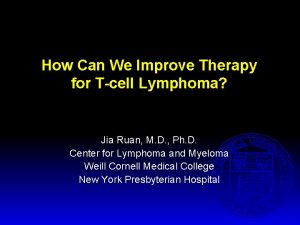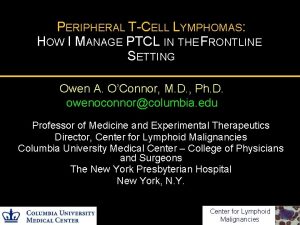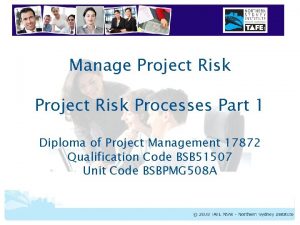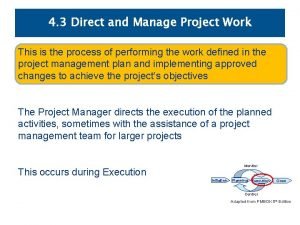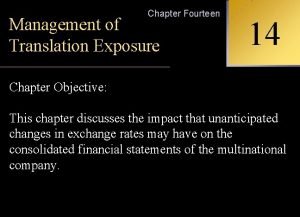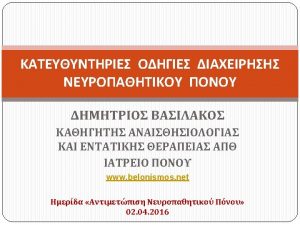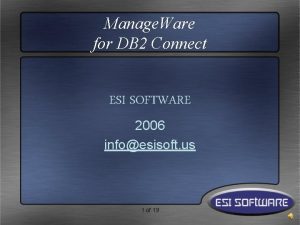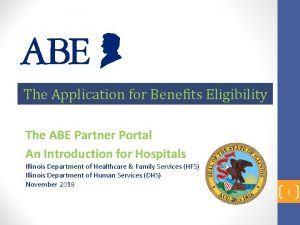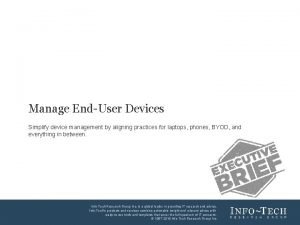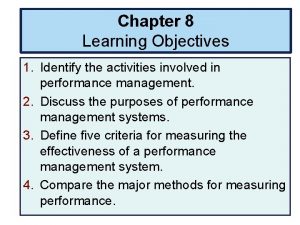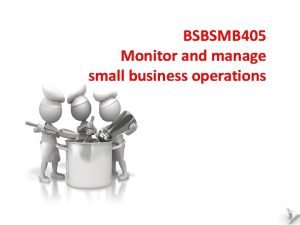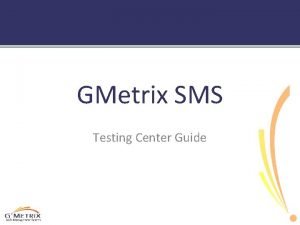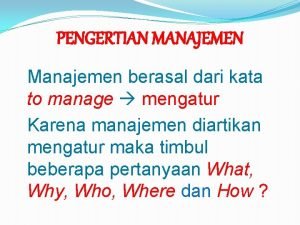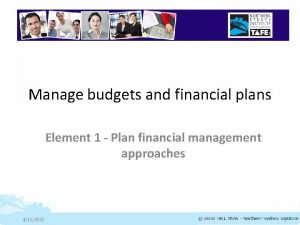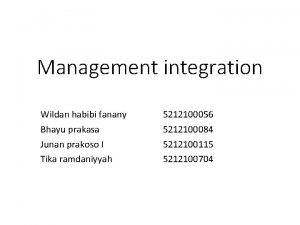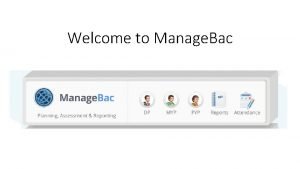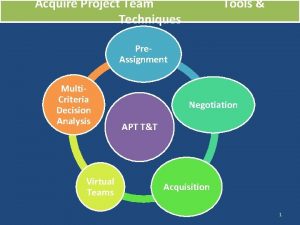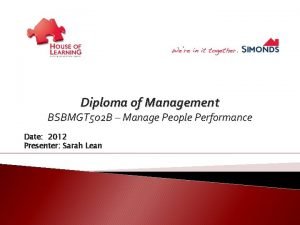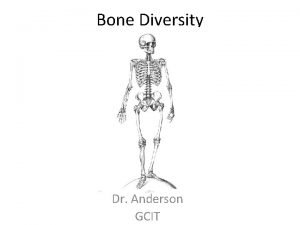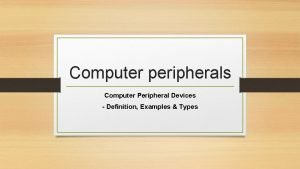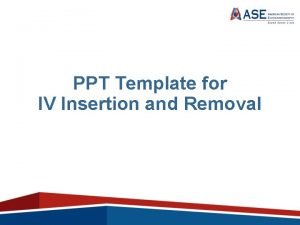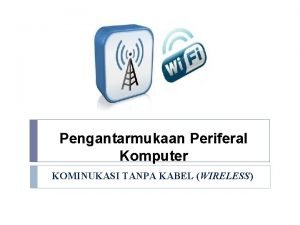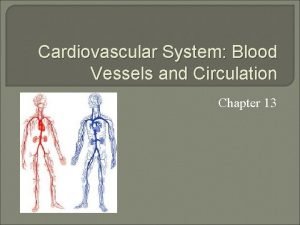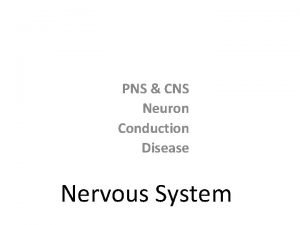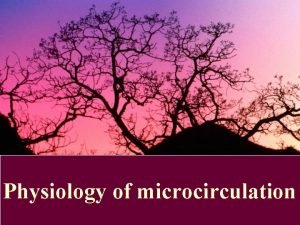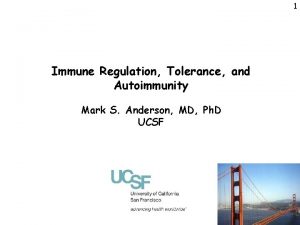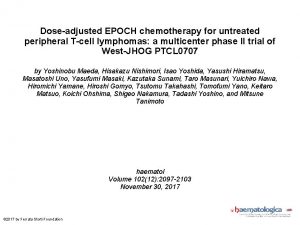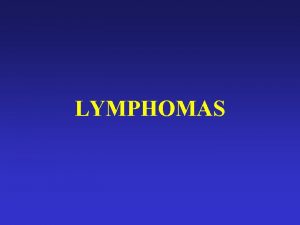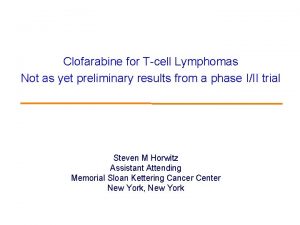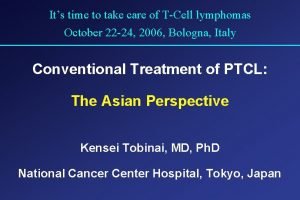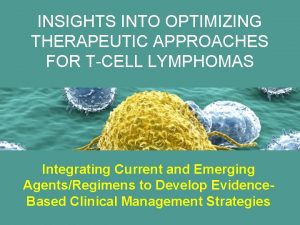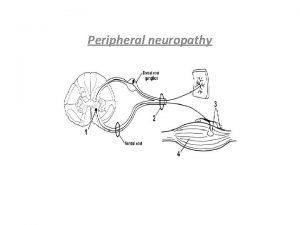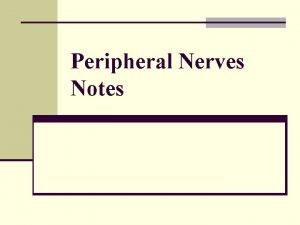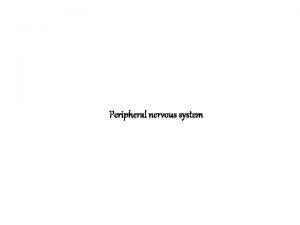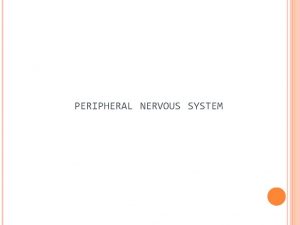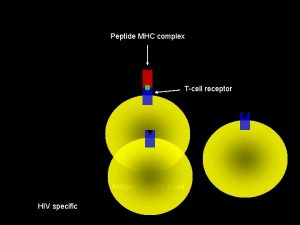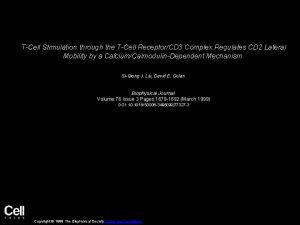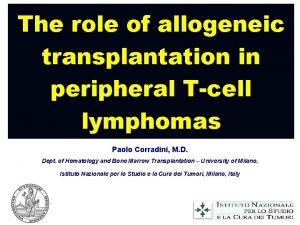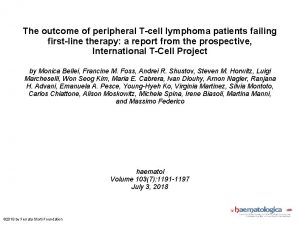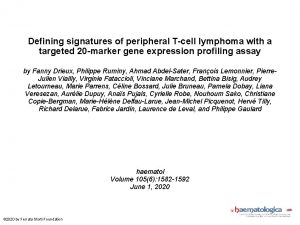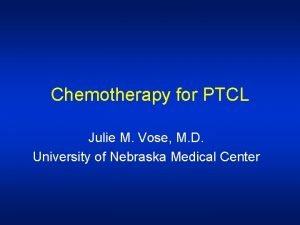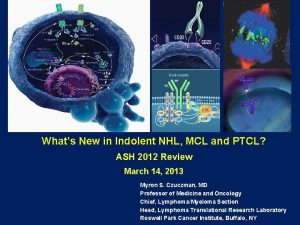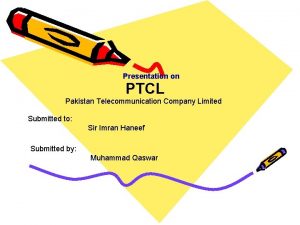PERIPHERAL TCELL LYMPHOMAS HOW I MANAGE PTCL IN































































- Slides: 63

PERIPHERAL T-CELL LYMPHOMAS: HOW I MANAGE PTCL IN THE FRONTLINE SETTING Owen A. O’Connor, M. D. , Ph. D. owenoconnor@columbia. edu Professor of Medicine and Experimental Therapeutics Director, Center for Lymphoid Malignancies Columbia University Medical Center – College of Physicians and Surgeons The New York Presbyterian Hospital New York, N. Y. Center for Lymphoid Malignancies

PERIPHERAL T-CELL LYMPHOMAS: HOW I MANAGE FRONTLINE DISEASE · Putting The T-cell Lymphomas in Context · What Are the Optimal Upfront Treatment Considerations · Bridging Patients with Relapsed or Refractory Disease with Novel Drugs · Conclusion

MOST COMMON PTCL SUBTYPES · PTCL-NOS is the most common subtype · Anaplastic large cell lymphoma (ALCL) ALK+/- and angioimmunoblastic lymphoma are also common subtypes Peripheral T-cell lymphoma, not otherwise specified Angioimmunoblastic T-cell lymphoma Extranodal NK/T-cell lymphoma, nasal type Adult T-cell leukemia/lymphoma Anaplastic large cell lymphoma, ALK+ Anaplastic large cell lymphoma, ALKEnteropathy-associated T-cell lymphoma Primary cutaneous anaplastic large cell lymphoma Hepatosplenic T-cell lymphoma Subcutaneous panniculitis-like T-cell lymphoma Unclassifiable peripheral T-cell lymphoma Other disorders Source: Adapted from Armitage J, et al. J Clin Oncol. 2008; 26: p 4125. Reprinted with permission. © 2008 American Society of Clinical Oncology. All rights reserved. 1. Armitage J, et al. J Clin Oncol. 2008; 26: 4124– 4130.

CLASSIFICATION OF PERIPHERAL T-CELLL YMPHOMA (PTCL) · PTCL is a heterogeneous group of aggressive mature T-/NK-cell lymphomas 1 2008 WHO Classification of Major Subtypes 2, 3 NHL Neoplasm Grouping – PTCL does not refer to anatomic sites, but rather to the involvement of more mature (post-thymic) T cells vs pre-thymic or immature T cells 1 Non-Hodgkins Lymphoma T-/NK-cell Neoplasms B-cell Neoplasms Mature T-/NK-cell Neoplasms Precursor Lymphoid Neoplasms T-Lymphoblastic Leukemia/Lymphoma Cutaneous Extranodal Nodal Leukemic Mycosis Fungoides (MF) NK/TCL Nasal Type Peripheral TCL-NOS Adult T-cell Leukemia/ Lymphoma Transformed MF Enteropathyassociated TCL Anaplastic Large Cell Lymphoma (ALK +/-) Sézary Syndrome Hepatosplenic TCL Angioimmunoblastic TCL Primary Cutaneous CD 30+ T-cell Disorders Subcutaneous Panniculitis-like TCL Primary Cutaneous Gamma/Delta TCL Aggressive 1. Armitage JO, et al. Ann Oncol. 2004; 15: 1447– 1449. 2. Adapted from Rodriguez J, et al. Crit Rev Oncol Hematol. 2008. 3. Adapted from Swerdlow SH, et al. WHO Classification of Tumours of Haematopoietic and Lymphoid Tissues. 2008. Aggressive NK-Cell Leukemia T-cell Prolymphocytic Leukemia T-cell Large Granular Lymphocytic Leukemia

NO IMPROVEMENTS IN SURVIVAL Source: International T-Cell Lymphoma Project. J Clin Oncol. 2008; 26: 4124 -4130 and courtesy of the T-Cell Project Executive Committee, unpublished data .

PTCL PROGNOSIS · Most PTCL subtypes have a worse prognosis than aggressive B-cell NHL – Median overall survival for most subtypes of PTCL is 1– 3 years 1, 2 – 5 -year overall survival is approximately 26%3 – ALK+ ALCL is an exception, with a 5 -year survival of 65– 90%2 Armitage JO, et al. Towards understanding the peripheral T-cell lymphomas. Ann Oncol. 2004; 15: 1447– 1449. by permission of Oxford University Press. 1. Armitage JO, et al. Ann Oncol. 2004; 15: 1447– 1449. 2. Savage KJ. Blood Rev. 2007; 21: 201– 216. 3. Rüdiger T, et al. Ann Oncol. 2002; 13: 140– 149.

NCCN- 2011 PTCL PRACTICE GUIDELINES FIRST LINE THERAPY FIRST-LINE THERAPY Clinical Trial Preferred CHOP appropriate for ALCL alk+ CHOEP, CHOP followed by ICE, CHOP followed by IVE Hyper. CVAD FIRST-LINE Consolidation All patients, except low risk IPI consider consolidation with high dose therapy and stem cell rescue (ALCL ALK Positive is a subtype with good prognosis and dose not need consolidative transplant if in remission NCCN Practice Guidelines in Oncology v 3. 2011

PERIPHERAL T-CELL LYMPHOMAS: HOW I MANAGE FRONTLINE DISEASE · Putting The T-cell Lymphomas in Context · What Are the Optimal Upfront Treatment Considerations · Bridging Patients with Relapsed or Refractory Disease with Novel Drugs · Conclusion

OVERALL SURVIVAL BY INITIAL TREATMENT PTCL-NOS Cases by Anthracycline Initial Treatment 1. 0 0. 9 0. 8 0. 7 Proportion 0. 6 0. 5 0. 4 Test: p=0. 14 0. 3 0. 2 0. 1 0. 0 0 1 2 3 4 5 6 7 8 9 10 11 12 13 14 15 16 Time Anthracycline as part of initial tx yes no CENSOR 98 14 FAIL 173 34 TOTAL 271 48 MEDIAN 2. 1 1. 57 International T-cell Non-Hodgkin’s lymphoma Study Group, ASH 2005 17 18

Baseline with CHOP/CHOP-Like Therapy: PTCL-By IPI: Is there Favorable Risk Disease? 1. 0 Cumulative Survival 0. 8 0, 1 (n = 36) 0. 6 0. 4 2, 3 (n = 54) 0. 2 0 CR: 64% PFS: 24% 4, 5 (n = 27) 0 2 4 6 8 OS (Yrs) 10 12 14 16 Courtesy British Columbia Cancer Agency

ARE ETOPOSIDE CONTAINING REGIMENS BETTER? Breakdown by Subtype of T-Cell Lymphoma PTCL subtype N pts ALCL alk+ 78 ALCL alk- 113 PTCLNOS 70 AITL 28 Other 31 Total 320 Blood 2010; 116: 3418 -25

COLLECTIVE T-CELL LYMPHOMA EXPERIENCE OVERALL SURVIVAL AS FUNCTION OF HISTOLOGICAL SUBTYPES (N=295) 1 3 -years OS-rate: 0. 9 0. 8 ALK+: ALK-: PTCL: AILT: T/NK: 0. 7 88. 8% (95% CI: 80. 8%-96. 8%) 63. 3% (95% CI: 53. 9%-72. 7%) 52. 9% (95% CI: 40. 2%-65. 6%) 65. 9% (95% CI: 47. 7%-84. 1%) 48. 9% (95% CI: 25. 4%-72. 4%) Proportion 0. 6 0. 5 2 0. 4 1: ALK+ (n= 73) 0. 3 2: ALK- (n= 108) 0. 2 3: PTCL (n= 68) 4: AILT (n= 28) 0. 1 5: T/NK (n= 18) 0 0 10 20 30 40 50 60 Months 70 80 90 p-values 3 4 1 <0. 001 2 0. 350 3 4 5 0. 001 <0. 001 0. 958 0. 339 0. 537 0. 700 0. 472 100 110 Schmitz et al. , Blood 2010; 116(18): 3418

EVENT FREE SURVIVAL OF 320 PATIENTS WITH T-CELLL YMPHOMA ACCORDING TO HISTOLOGIC SUBTYPE 100 90 Event Free Survivial % 80 70 60 50 40 ALCL/ALK+ (n=78) 30 AITL (n=28) ALCL/ALK- (n=113) 20 PTCLU (n=70) Other (n=31) 10 0 0 10 20 30 40 50 60 70 80 90 100 110 Months Schmitz et al. , Blood 2010; 116(18): 3418

PATIENTS WITH OTHER MAJOR SUBTYPES (PATIENTS WITH ALK+ ORA LCL EXLCUDED) GERMAN HIGH-GRADE NHL STUDY GROUP (DSHNHL) www. lymphome. de/en/Groups/DSHNHL 100 90 80 70 % 60 Etoposide (n=69) 50 40 non Etoposide (n=29) 30 20 p=0. 057 10 0 0 10 20 30 40 50 60 70 80 90 100 110 Months EFS OF YOUNGER PATIENTS (18 -60 YEARS LDH<=UNV) , TREATED ON THE NHL-B 1 ORH I-CHOEP PHASE II/III TRIALS Schmitz et al. , Blood 2010; 116(18): 3418

Nordic PTCL project NLG-T-01: 2001 -2007 Design and schedule Excluded: 1) Alk pos ALCL T/0 2) CTCL 3) Leukemic TNHL CHOEP-14 d x 3 CR, PR SD, PD CHOEP-14 d x 3 (stem cell collection) CR, PR SD, PD HDT (BEAM) Follow-up d’Amore et al EHA 2009: abs. #53

NLG-T-01 • Intention-to-treat Population • Only 50% of patients in CR 3 months post ASCT • Higher fraction than expected made it to ASCT d’Amore et al EHA 2009: abs. #53

NLG STUDY: AUTOLOGOUS BMT IN FIRST REMISSION (MEDIAN F/U: 45 MOS) PTCL-NOS AILT ALCL, ALKEATL 10 10 80 PFS (%) OS (%) 80 60 40 20 Log-rank test P =. 21 0 12 24 36 48 Mos PTCL-NOS AILT ALCL, ALKEATL 60 Subtype, % 0 72 Log-rank test P =. 26 0 12 24 OS 36 48 Mos 60 PFS 3 Yrs 5 Yrs PTCL-U (n = 62) 51 47 43 38 AILT (n = 30) 57 52 54 49 ALCL, ALK- (n = 31) 77 70 64 61 Enteropathy (n = 21) 52 48 47 38 d’Amore F, et al. European Hematology Association 2009. Abstract 53. d’Amore F, et al. J Clin Oncol. 2012; 30: 3093 -3099. 72

AUTOLOGOUS STEM CELL TRANSPLANTATION (AUTOSCT) AS FIRSTLINE THERAPY IN PERIPHERAL T-CELL LYMPHOMAS (PTCL): RESULTS OF A PROSPECTIVE MULTICENTER STUDY DESIGN PR/CR Dexa. BEAM / ESHAP CHOP-21 CHOP-21 PTCL CHOP-21 Collection of stem cells Cyc 120 mg / kg + TBI Auto. SCT PR/CR Reimer et al. , 2009

AUTOLOGOUS STEM CELL TRANSPLANTATION (AUTOSCT) AS FIRSTLINE THERAPY IN PERIPHERAL T-CELL LYMPHOMAS (PTCL): OUTCOME n= 83 N = 24 progressive disease N = 2 patient request N = 2 other PTCL n= 28 n= 55 Auto. SCT No auto. SCT n= 3 Complete Remission n= 2 Alive with Disease n= 23 n= 32 Dead Complete Remission n= 6 Alive with Disease n= 17 Dead Reimer et al. , 2009, JCO 27(1): 106 -113

GERMAN PROSPECTIVE STUDY: OS AFTER ASCT IN FIRST REMISSION Transplanted (n = 55) 0. 8 0. 6 0. 4 N = 83 CHOP x 4 -6 If ≥ PR, dexa. BEAM or ESHAP ± TBI Median follow-up: 33 mos Nontransplanted (n = 28) 0. 2 P <. 001 0 0 12 24 36 48 Mos • • • 1. 0 PIT group 1: 0 risk factors PIT group 2: 1 risk factor PIT group 3: 2 risk factors PIT group 4: 3 -4 risk factors Reimer P, et al. J Clin Oncol. 2009; 27: 106 -113. 60 Proportion Achieving OS Nontransplanted patients did poorly Poor-risk patients did poorly 1. 0 PIT group 1 (n = 25) 0. 8 PIT group 2 (n = 34) 0. 6 0. 4 PIT group 4 (n = 3) 0. 2 0 PIT group 3 (n = 21) P =. 0414 0 12 24 36 Mos 48 60

ASCT 1 st line in PTCL OS + PFS in the two largest PTCL-restricted ASCT trials NLG-T = Etoposide in Induction vs Reimer = No Etoposide in Induction NLG-T-01 (EHA 09) Reimer et al (JCO 09) 3 -yrs 57% 48% 5 -yrs 50% 40% OS NLG-T-01 (EHA 09) Reimer et al (JCO 09) 3 -yrs 49% 36% 5 -yrs 43% n. d. PFS Differences in treatment schedule Induction Conditioning regimen Nordic trial CHOEP-14 x 6 BEAM German trial CHOP-21 x 4 -6 + Dexa. BEAM (mobilizing) Hd. Cy+TBI

AUTOLOGOUS STEM CELL TRANSPLANT IN FIRST REMISSION – PROSPECTIVE DATA Study Author (Yr) n Regimen Transplanted, % Outcomes, % Corradini (2006) 62 Mitoxantrone/ melphalan or BEAM 73 12 -yr EFS: 30 12 -yr OS: 34 Rodriguez (2007) 26 Mega. CHOP ± IFE 73 3 -yr PFS: 56 3 -yr OS: 84 Mercadal (2008) 41 High-dose CHOP/ESHAP 41 4 -yr PFS: 30 4 -yr OS: 39 Reimer (2009) 83 dexa. BEAM or ESHAP ± TBI 66 3 -yr PFS: 36 3 -yr OS: 48 d’Amore (2011) 160 CHO(E)P-14 x 6 ± BEAM/BEAC 71 5 -yr OS: 51 5 -yr PFS: 44 Corrandini P, et al. Leukemia. 2006; 20: 1533 -1538. Rodriguez J, et al. Eur J Haematol. 2007; 79: 32 -38. Mercadal S, et al. Ann Oncol. 2008; 19: 958 -963. Reimer P, et al. J Clin Oncol. 2009; 27: 106 -113. d’Amore F, et al. ASH 2011. Abstract 331.

ICE and Planned ASCT for Relapsed/Refractory T-cell Lymphoma: PFS from ICE Progress Free Survival PFS: Relapsed versus Refractory 1. 0 0. 8 0. 6 % % ALL, N=40 0. 4 Rel, N=22 0. 2 Ref, N=18 0. 0 0 12 24 36 48 60 72 84 96 108 120 132 0 12 24 36 60 72 84 96 108 120 132 PFS ICE months Response to ICE 70% (28/40) 48 Received ASCT 68% (27/40) PTCL is Not DLBCL Horwitz et al, ASH 2005

PERIPHERAL T-CELL LYMPHOMAS: HOW I MANAGE FRONTLINE DISEASE · Putting The T-cell Lymphomas in Context · What Are the Optimal Upfront Treatment Considerations · Bridging Patients with Relapsed or Refractory Disease with Novel Drugs · Conclusion

PROPEL SUMMARY OF RESPONSE 70% of responders did so in Cycle 1 Best Response Central Review (N=109) n Percent Investigator Assessment (N=109) n Percent CR+CRu+PR 32 29% 43 39% CR CRu PR SD PD UE ND: off-treatment in Cycle 1 11 1 20 21 40 2 10% 1% 18% 19% 37% 2% 17 3 23 22 40 0 16% 3% 21% 19% 37% 0% 14 13% 5 5% O. A. O’Connor et al. , JCO, 2011; 29(9): 1182 -1189

CASE MATCHING PROCEDURES USING 4 DATABASES FROM 3 CONTINENTS Very Closely Matched Patients Populations Timeframe N MSK UNMC GELA SMC Total 1997 -2011 1984 -2010 1997 -2008 1995 -2007 1984 -2011 171 76 117 504 Medical review 1: 1 match MSK UNMC GELA SMC Pralatrexate N 868 - 390 109 280 75 92 75 66 66 868 Patients with: Relapsed/refractory PTCL Appropriate histology No pralatrexate Matched by: (1) Histology (2) No. therapies (3) Age ranges (4) Gender Historical control N Courtesy Charlie Morris

SIGNIFICANT IMPROVEMENT IN OS VERSUS MATCHED CONTROLS Hazard Ration = 0. 394 (95% CI: 0. 259, 0. 600) Pralatrexate Matched Controls Courtesy Charlie Morris

PROPEL: AS 2 ND LINE THERAPY AFTER CHOP FAILURE § 15/109 had previously received CHOP as their first-line therapy § 11/15 had a prior response to CHOP (7 CR, 4 PR) § 2/15 remained on treatment at the time of data cut-off (12. 9 and 18. 5 months) § 2 patients proceeded to SCT after response to pralatrexate (censored at 2. 3 and 3. 3 months) § Remain in CR and disease free at publication (20. 1 and 21. 7 months) Shustov, et al, Blood (ASH Annual Meeting Abstracts) 2010 116: Abstract 4882

PROPEL: SUMMARY OF EFFICACY AS SECOND-LINE TREATMENT FOLLOWING CHOP FAILURE Efficacy Assessments Tumour Response ORR (CR+CRu+PR) CR CRu PR SD PD Not Evaluable Median Do. R Median by PFS** Median OS Central Review Assessment (n=15), % Investigator Assessment (n=15), % 7 (47) 3 (20) 0 (0) 4 (27) 4(27) 0 (0) ND* 8. 1 mths ND* 6 (40) 4 (27) 1 (7) 12. 5 mths 7. 4 mths ND* *ND- not determined, as there were insufficient events at the time of last follow-up; **per a Kaplan-Meier estimate CR=complete response; CRu=complete response unconfirmed; PR=partial response; SD=stable disease; PD=progressive disease; Do. R=duration of response; PFS=progression-free survival; OS=overall survival. Shustov, et al, Blood (ASH Annual Meeting Abstracts) 2010 116: Abstract 4882

SINGLE-AGENT ROMIDEPSIN IN RELAPSED PERIPHERAL T-CELL LYMPHOMA: EFFICACY Response Independent Review Committee Analysis (n = 130) Overall Response Rate 34 (26%) Complete response 10 (8%) Unconfirmed complete response 7 (5%) Duration of Response Overall Complete response/unconfirmed complete response Median (Range) 12 (< 1. 0 -26. 0+) months Not reached (< 1. 0 -26. 3+) months) • Responses reported in PTCL (not otherwise specified) (29%), angioimmunoblastic TCL (33%), and ALK 1– ALCL (24%) • Similar response rates in patient subgroups according to number of prior therapies (< 3 vs. ≥ 3), prior SCT (yes vs. no), and refractory to most recent therapy (yes vs. no) Coiffier et al. JCO, 2012; Jan. 23 (epub ahead of print)

International PTCL Study Subtype (n) CD 30 Expression (%) 0 -5% 6 -49% 50 -80% >80% PTCL-NOS (168) 54 32 7 7 AITL (167) 55 42 2 1 EATL (27) 74 11 ATLL (120) 50 37 8 5 Nasal NK/T (73) 53 34 6 7 Extranasal NK/T (30) 27 27 23 23 Courtesy Dennis Weisberger, University of Nebraska

100 75 50% OS PFS 50 25 0 40% 75 50 25 0 0 1 2 3 4 5 6 7 8 9 10 11 12 Yrs After Transplantation 75 50 25 0 51% 8% Sensitive Refractory 0 1 2 3 4 5 6 7 8 9 10 11 12 100 P <. 0001 0 1 2 3 4 5 6 7 8 9 10 11 12 Yrs After Transplantation • • • P = NS Yrs After Transplantation PFS (%) 100 PTCL-NOS AILD ALCL Others 100 OS (%) Survival (%) REDUCED-INTENSITY ALLOGENEIC BMT IN RELAPSED PTCL: RETROSPECTIVE DATA 75 ≤ 2 previous regimens > 2 previous regimens 54% 50 25 0 16% P <. 0026 0 1 2 3 4 5 6 7 8 9 10 11 12 Yrs After Transplantation 52 patients; 12 had DLI for relapse Chemosensitive patients (n = 39) did better Patients who had > 2 previous regimens (n = 13) had inferior outcomes Dodero A, et al. Leukemia. 2012; 26: 520 -526.

AN ALGORITHM FOR THE MANAGEMENT OF PTCL-NOS UPFRONT Confirm Hematopathology : CD 30, CD 52 Expression Baseline CT/PET and Bone Marrow Biopsy, full skin exam with punch biopsy of suspicious lesions; HLA Typing, viral studies including HTLV-1, HIV Combination Chemotherapy: EPOCH / CHOEP x 6 – 8 cycles Complete Remission Autologous Stem Cell Transplant Relapse Complete Remission Partial Remission or Worse Pralatrexate Romidepsin Brentuximab Gemcitabine Partial Remission or Worse Consider Allogeneic Stem Cell Transplant Palliative Care

Peripheral T-Cell Lymphomas: How I Manage Frontline Disease • CHOP clearly inferior, but is a regulatory standard. Integrating etoposide may provide advantage? • Caution removal of doxorubicin based upon the T-cell Lymphoma Project • Consolidation with ASCT probably beneficial, and more so then in the relapsed or refractory setting • Allogeneic stem cell transplant should be considered in eligible patients with R/R disease • USE NEWER FDA APPROVED DRUGS earlier in the natural history of the disease. • Many new studies emerging as CHOP additions (Pralatrexate, Romidepsin, Brentuximab vedotin, Belinostat)

THANK YOU

Peripheral T-Cell Lymphomas: How I Manage Frontline Disease · Putting The T-cell Lymphomas in Context · Defining ‘Standards of Care’ for Upfront Treatment (won’t take long) · Newly Emerging Options for Advanced (R/R) Disease: Is combination the right way to go? - Pralatrexate in Relapsed/Refractory PTCL - Targeting the Epigenome in PTCL - Targeting CD 30+ T-cell Malignancies · Conclusion

NCCN GUIDELINES FOR RELAPSED OR REFRACTORY PTCLSA CLINICAL TRIAL IS RECOMMENDED FIRST! Relapsed/ refractory disease Additional therapy Response #2 Complete response -or. Partial response Consolidation/ additional therapy Clinical trial -or. Auto- or allo- SCT Relapse #2 or greater Clinical trial Candidate for preferred high-dose -ortherapy Second-line Clinical trial b therapy -or. Relapsed/ Best supportive care No response Refractory -ordisease Palliative RT Clinical trial preferred -or. Non-candidate b Clinical trial preferred for 1 st and 2 nd relapse; for high-dose Second-line therapy no therapies other than clinical trial described -ortherapy for 2 nd relapse Palliative RT a b Reproduced from NCCN Practice Guidelines in Oncology – v. 2. 2009. See suggested regimens (TCEL-B).

MECHANISM OF ACTION AND BIOMARKER DISCOVERY RFC 1; FPGS; DHFR; GARPH; OTHER? Pralatrexate >> > Methotrexate Cell membrane RFC-1 Extracellular Folate Pralatrexate DNA d. TMP FPGS DHFR TS d. UMP Cytosol Pralatrexate-Glu(n) THF AMP IMP 5. 10 methenyl THF GMP 10 formyl THF AICARFT GARFT PRPP RNA DNA

PROPEL ELIGIBLE HISTOLOGIES T-/NK-cell neoplasms Mature T-/NK-cell neoplasms Precursor lymphoid neoplasms Cutaneous Extranodal Nodal Leukemic ®Blastic NK ®Mycosis ®T/NK-cell ®PTCL – ®Adult T-cell lymphoma fungoides (MF) lymphoma – unspecified lymphoma/ ®Precursor T/NK ®Transformed MF nasal ®Anaplastic large leukemia ®Enteropathyneoplasms -cell lymphoma, (HTLV 1+) ®Sézary type intestinal ®T/NK-cell primary Syndrome lymphoma leukemia/ systemic type ®Primary lymphoma ®Hepatosplenic ®Angioimmunocutaneous T-cell lymphoma blastic T-cell ®T-cell CD 30+ prolymphocytic lymphoma disorders: ALCL ®Subcutaneous leukemia (Tpanniculitis and PLL) T-cell lymphomatoid ®T-cell large papulosis ®Peripheral T/NKgranular cell lymphoma lymphocytic unspecified Adapted from Jaffe et al. WHO Classification of Tumours of Haematopoietic and Lymphoid Tissues. 2001.

PROPEL NUMBER OF PRIOR SYSTEMIC REGIMENS N=111 Number of Regimens 1 2 3 4 ≥ 5 Median (range) n 23 30 23 14 21 3. 0 (1 -12) Percent 21% 27% 21% 13% 19% 53% of patients had no evidence of response to the most recent line of prior therapy 25% of patients had no evidence of response to any prior therapy O. A. O’Connor et al. , JCO, 2011; 29(9): 1182 -1189

PROPEL RESPONSE BY KEY SUBSETS Parameter Region Histology Prior transplant Category IWC Response Rate 95% CI North America Europe 27 / 85 (32%) 5 / 24 (21%) (22%, 43%) (7%, 42%) PTCL NOS Anaplastic LC Angioimmunoblastic Transformed MF Other 19 / 59 (32%) 6 / 17 (35%) 1 / 13 (8%) 3 / 12 (25%) 3 / 8 (25%) (21%, 46%) (14%, 62%) (0%, 36%) (5%, 57%) (9%, 76%) Yes No 6 / 18 (33%) 26 / 91 (20%) (13%, 59%) (20%, 39%) OO. A. O’Connor et al. , JCO, 2011; 29(9): 1182 -1189

PROPEL RESPONSE BY PRIOR TREATMENT Parameter Category Response Rate 95% CI Prior systemic therapy 1 regimen 2 regimens > 2 regimens 8 / 23 (30%) 7 / 29 (24%) 17 / 57 (30%) (16%, 57%) (10%, 44%) (18%, 43%) Best Response to Any Prior Therapy CR / PR SD / PD / Unknown 25 / 83 (30%) 5 / 26 (19%) (21%, 41%) (7%, 39%) Response to Most Recent Therapy CR / PR SD / PD Unknown 13 / 40 (32%) 14 / 57 (25%) 3 / 12 (25%) (19%, 49%) (14%, 38%) (5%, 57%) Prior Methotrexate Yes No 5 / 21 (24%) 25 / 88 (28%) (8%, 47%) (19%, 39%) O. A. O’Connor et al. , JCO, 2011; 29(9): 1182 -1189

PROPEL DURATION OF RESPONSE BY CENTRAL REVIEW SCT 1. 00 SCT 0. 75 Proportion Number of Responders = 30 Median duration = 10. 1 months Updated SCT Permanently censored (eg, transplant) (n = 8) SCT Continue in follow-up for response (n=7) 0. 50 Follow-up exceeds 6 months for all patients who continue in follow-up for response 0. 25 0 0 3 6 9 12 15 18 Months O. A. O’Connor et al. , JCO, 2011; 29(9): 1182 -1189

ROMIDEPSIN ONGOING STUDIES IN PTCL NCI Trial (NCI 1312) Romidepsin 14 mg/m 2 days 1, 8, 15 of a 28 day cycle Romidepsin GPI 06 -0002 14 mg/m 2 Registration days 1, 8, 15 Trial of a 28 day cycle O B J E C T I V E Response Rate Patient Criteria: Response Duration PTCL Relapsed or progressive Safety >1 prior “chemotherapy” Response Rate Patient Criteria: Response Duration PTCL Relapsed or progressive Safety >1 prior systemic therapy

PHASE 2 ROMIDEPSIN IN PTCL RESPONSE RATES Overall Response Rates All Pts N=48 Pts ≥ 2 cycles** N=34 15 (31%) 15 (44%) CR*, n (%) 4 (8%) 4 (12%) PR, n (%) 11 (23%) 11 (32%) SD, n(%) 7 (15%) 7 (21%) ORR (CR+PR), n (%) s Piekarz et al. , Blood, 2011; 117(2): 5827 -5834

PHASE 2 ROMIDEPSIN IN PTCL RESPONSE DATA Duration of Response (DOR) &Time to Disease Progression (TTP) Median time to first response was 1. 8 (1 -6) months Population N* Median (range) DOR in months ORR (CR & PR) 15 9 (2 – 61+) 12 (4 – 63+) CR 4 34 (3 – 61+) NR (14 – 63+) PR 11 8 (2 – 41+) 10 (4 – 42+) SD 7 – 9 (3 – 26+) PD 19 – Median (range) TTP in months 1. 4 (. 2– 4) *7 patients were not evaluable; NR, median not yet reached; + denotes continuing response Piekarz et al. , Blood, 2011; 117(2): 5827 -5834

PHASE II TRIAL OF ROMIDEPSIN IN RELAPSED OR PROGRESSIVE PERIPHERAL T-CELL LYMPHOMA FOLLOWING PRIOR SYSTEMIC THERAPY • Patient population: – 131 enrolled – 130 with confirmed PTCL – Failed ≥ 1 prior systemic therapy • Treatment regimen: romidepsin 14 mg/m 2, days 1, 8, and 15 q 28 days × 6 cycles; continued beyond 6 cycles in responding patients at investigator and patient discretion • Primary endpoint: CR/CRu by independent review • Secondary endpoints including: ORR, duration of response, TTP, tolerability, and safety Coiffier et al. JCO, 2012; Jan. 23 (epub ahead of print)

Peripheral T-Cell Lymphomas: How I Manage Frontline Disease · Putting The T-cell Lymphomas in Context · Defining ‘Standards of Care’ for Upfront Treatment (won’t take long) · Newly Emerging Options for Advanced (R/R) Disease: Is combination the right way to go? - Pralatrexate in Relapsed/Refractory PTCL - Targeting the Epigenome in PTCL - Targeting CD 30+ T-cell Malignancies · Conclusion

CD 30 Expression in in Non-Lymphoma Tumors § § Acute Myeloid Leukemia/Granulocytic Sarcoma § – M Fickers 1996, J Clin Pathol 49: 7623; R Horie 1999, Am J of Path. 155: 2029 -41 § ALL and AML – Gattei 1997, Blood 89: 2048 -59 § § Mastocytosis § § M Garcia-Prats 1998, Histopathology 32: 462 -472 Sotlar 2010, Modern Pathology, 1 -11 Mesothelioma – M Garcia-Prats 1998, Histopathology 32: 462 -472; C Dunphy 2000, Arch Pathol Lab Med 124: 1077 -79 Nasopharyngeal carcinoma § § Kneile 2006, Histopathology 48: 855861 Testicular embryonal carcinoma – J Ferreiro 1994, Hum. Pathol. 25: 522524; K Iczkowski 2008, Hum. Pathol. 39: 275 -281 § Lung (Adenocarcinoma) § § – Internal data on file Bone sarcomas – G Mechtersheimer 1990, Cancer 66: 1732 -37 Melanoma Thyroid Carcinoma (Medullary, Papillary) – M Trovato 2001, Thyroid 11: 621 -8 § Cervical, Head and Neck SCC (Viralassociated cancers), Lung, Breast, Endometrial, Ovarian, Prostate, & Melanoma – Human protein atlas (http: //www. proteinatlas. org/ENSG 0000 0120949/cancer)

CD 30 Expression in DLBCL Citation CD 30+ High CD 30+ 4% (2/45) 0% (0/45) Norton et al. , 1987 11% (3/28) 7% (2/28) Hall et al. , 1988 10% (6/60) 2% (1/60) Schwarting et al. , 1989 29% (35/121) 9% (11/121)* Miettinen, 1992 38% (14/37) 11% (4/37) Noorduyn et al. , 1994 40% (36/91) 23% (21/91) 4% (3/67) 0% (0/67) Stein et al. , 1985 Eow et al. , 2006 Total 22% (99/449) 9% (39/449) Courtesy Dennis Weisberger, University of Nebraska

Anaplastic Large cell Lymphoma: A Unique Entity Among PTCL Overall Survival After Failure of Primary Therapy 2 • 40 65% of patients develop recurrent disease after initial multiagent chemotherapy 1 • To improve OS, durable responses must be attained – few therapies available for this unmet need Survival • s. ALCL is a CD 30 -positive aggressive subtype of peripheral T-cell lymphoma Median = 3. 3 months N = 61 Time (years) 1 Savage et al, 2008 2 Data provided by J. Connors, BC Cancer Agency

BRENTUXIMAB VEDOTIN MECHANISM OF ACTION Brentuximab vedotin (SGN-35) ADC monomethyl auristatin E (MMAE), potent antimicrotubule agent protease-cleavable linker anti-CD 30 monoclonal antibody ADC binds to CD 30 ADC-CD 30 complex traffics to lysosome MMAE is released MMAE disrupts microtubule network G 2/M cell cycle arrest Apoptosis

DEMOGRAPHICS AND BASELINE CHARACTERISTICS Age* Gender ECOG status 0 1 2 ALCL confirmed by central pathology ALK-negative Refractory to frontline therapy Refractory to most recent treatment No response to any prior treatment Prior chemotherapy regimens* Prior radiation Prior ASCT N=58 52 yr (14 76) 33 M / 25 F 33% 66% 2% 97% 72% 62% 50% 22% 2 (1 6) 45% 26% * Median (range) R. Advani, ASH Abstract 443, 2011

KEY RESPONSE RESULTS SUMMARY N=58 Objective response rate (95% CI) 86% (75, 94) Median duration of OR (95% CI) 12. 6 mo (5. 7, ) CR rate (95% CI) 57% (43, 70) Median duration of response in patients with CR (95% CI) 13. 2 mo (10. 8, ) Median PFS (95% CI) 13. 3 mo (6. 9, ) Median OS Not reached R. Advani, ASH Abstract 443, 2011

Tumor Size (% Change from Baseline) Maximum Tumor Reduction Complete remission 97% of patients achieved tumor reduction Individual Patients (n=57) R. Advani, ASH Abstract 443, 2011

PFS by Disease Response Media % Patients Free of PD or Death n PFS (mont hs) CR 14. 6 PR 4. 2 SD 2. 7 * Histologically ineligible PD 1. 2 HI* Time (months) R. Advani, ASH Abstract 443, 2011

% Patients Free of PD or Death PFS: Brentuximab Vedotin vs. Last Prior Therapy PFS brentuximab vedotin*; median = 14. 3 months PFS last prior therapy; median = 5. 9 months HR=0. 48 (p=0. 001) Time (months) 91% of the most recent prior therapies were multiagent chemotherapy or ASCT * Investigator-assessed R. Advani, ASH Abstract 443, 2011

STRATEGIES TO IMPROVE UPFRONT THERAPY FOR PTCL CHOP based + Etoposide- CHOEP, EPOCH + Alemtuzumab + Pralatrexate + anti CD 4 + anti CXC 4 + lenalidomide + Brentuximab vendotin Novel combinations PEGS (cisplatin, etoposide, gemcitabine, methylprednisolone) Pralatrexate + Bortez + SAHA Pralatrexate + Romidepsin Novel targeted agents + monoclonal antibodies

Thank You

AUTOLOGOUS STEM CELL TRANSPLANTATION (AUTOSCT) AS FIRSTLINE THERAPY IN PERIPHERAL T-CELL LYMPHOMAS (PTCL): IMPROVED OVERALL SURVIVAL WITH ASCT Overall survival Transplanted vs. non-transplanted IPI: high / interm. high vs. low / interm. low p< 0. 001 p= 0, 1799 estimated 3 -year OS: 71% vs. 11% time (months) transplanted (n= 55) non-transplanted (n= 28) high / interm. high (n= 42) low / interm. low (n= 41) Reimer et al. , 2009, JCO 27(1): 106 -113

NLG-T-01: OS + PFS (Med follow-up 45 mos) OS : ALCL, AIL, PTCL-NOS 0 12 24 36 48 analysis time rhistdia = ptcl, nos rhistdia = alcl, alk neg 60 72 0. 00 0. 20 0. 40 0. 60 0. 80 1. 00 Subtype Analysis rhistdia = aild PFS : ALCL, AIL, PTCL-NOS 0 12 24 36 48 60 72 analysis time rhistdia = ptcl, nos rhistdia = aild rhistdia = alcl, alk neg OS Subtype PFS 3 -yr 5 -yr PTCLu (n=62) 51% 45% 43% 34% AIL (n=30) 57% 50% 54% 47% ALCL alk-neg (n=31) 77% 73% 64% Enteropathy (n=21) 52% 44% 47% 40% d’Amore et al EHA 2009: abs. #53

PROPEL: PRIORICE § 20/109 had previously received ICE-based regimen 2 nd line § ORR to ICE-based regimens was 25% (3 CR, 2 PR) § Median duration on treatment for responders was <1 month § 9/20 received an ICE-based regimen immediately before pralatrexate § Of those 9, 2 did not respond to the ICE-based regimen, but did respond to pralatrexate (1 CR, 1 PR) Goy A, et al, Blood (ASH Annual Meeting Abstracts) 2010 116: Abstract 1753

PROPEL: PRIOR ICE (N=20) Central Review Assessment (n=20), % Investigator Assessment (n=20), % ORR (CR+PR) 8 (40) CR 5 (25) 3 (15) PR 3 (15) 5 (25) SD 5 (25) 2 (10) PD 6 (30) 4 (20) Not Evaluable 1 (5) 6 (30) 16. 2 mths 13. 1 mths Efficacy Assessments Tumor Response Median Do. R • ORR (CR + PR): 40% • CR: 25% by Investigator Assessment • Median Duration of Response: 16. 2 months by Investigator Assessment Goy A, et al, Blood (ASH Annual Meeting Abstracts) 2010 116: Abstract 1753
 Brentuximab vedotin ptcl
Brentuximab vedotin ptcl Romidepsin ptcl
Romidepsin ptcl Bsbpmg508a manage project risk
Bsbpmg508a manage project risk User manager for domains
User manager for domains Bsbcus501
Bsbcus501 Direct and manage project work inputs
Direct and manage project work inputs Lab 5: manage active directory accounts (module 4)
Lab 5: manage active directory accounts (module 4) Emotions influence driving because they
Emotions influence driving because they Management of translation exposure
Management of translation exposure Res pain management
Res pain management Direct and manage project execution
Direct and manage project execution Manage influencer database
Manage influencer database Wareneingangsschein
Wareneingangsschein If you can't measure it you can't manage it
If you can't measure it you can't manage it Abe manage my case
Abe manage my case Manage end user devices
Manage end user devices Paradigma let the manager manage
Paradigma let the manager manage Kurzfristiges fremdkapital
Kurzfristiges fremdkapital Chapter 8 learning to manage
Chapter 8 learning to manage Quotes on measurement
Quotes on measurement Manage and maintain small/medium business operations
Manage and maintain small/medium business operations Contact 2. hali
Contact 2. hali Manageengine
Manageengine Istilah manage berasal dari bahasa
Istilah manage berasal dari bahasa Money management decisions attempt to manage a firm's
Money management decisions attempt to manage a firm's List three strategies for handling anger in a healthful way
List three strategies for handling anger in a healthful way Help verb pattern
Help verb pattern Gmetrix admin
Gmetrix admin Manajemen berasal dari kata
Manajemen berasal dari kata Manage budget and financial plans
Manage budget and financial plans Stakeholder mapping exercise
Stakeholder mapping exercise Direct and manage project work
Direct and manage project work Manage bac
Manage bac Manage engine application manager
Manage engine application manager Pre assignment project management
Pre assignment project management Bsbmgt502 manage people performance
Bsbmgt502 manage people performance Edu.manage
Edu.manage Manage men tactfully
Manage men tactfully Manage dynamic dashboards
Manage dynamic dashboards If you can't measure it you cannot improve it
If you can't measure it you cannot improve it Managing economic exposure and translation exposure
Managing economic exposure and translation exposure E-rs manage your referral (myr)
E-rs manage your referral (myr) Compare sources of information on professional development
Compare sources of information on professional development You cant manage what you dont measure
You cant manage what you dont measure Keep satisfied manage closely monitor keep informed
Keep satisfied manage closely monitor keep informed Manage draft beer
Manage draft beer My rotary learning centre
My rotary learning centre Manage personal and professional development
Manage personal and professional development Harvard spark program
Harvard spark program Peripheral skeleton
Peripheral skeleton Central and peripheral route to persuasion
Central and peripheral route to persuasion Welding symbols
Welding symbols What is computer peripherals examples
What is computer peripherals examples A is a thin lighter-weight mobile computer that has
A is a thin lighter-weight mobile computer that has Iv procedure ppt
Iv procedure ppt Peripheral komputer yang tanpa kabel disebut
Peripheral komputer yang tanpa kabel disebut 5 urban hearths
5 urban hearths Peripheral vasoconstriction
Peripheral vasoconstriction Peripheral network
Peripheral network Pain pathophysiology
Pain pathophysiology Prosedur pengoperasian kamera video
Prosedur pengoperasian kamera video Wikimedia commons
Wikimedia commons Sinusoidal vs fenestrated capillaries
Sinusoidal vs fenestrated capillaries Cellular and molecular immunology
Cellular and molecular immunology
